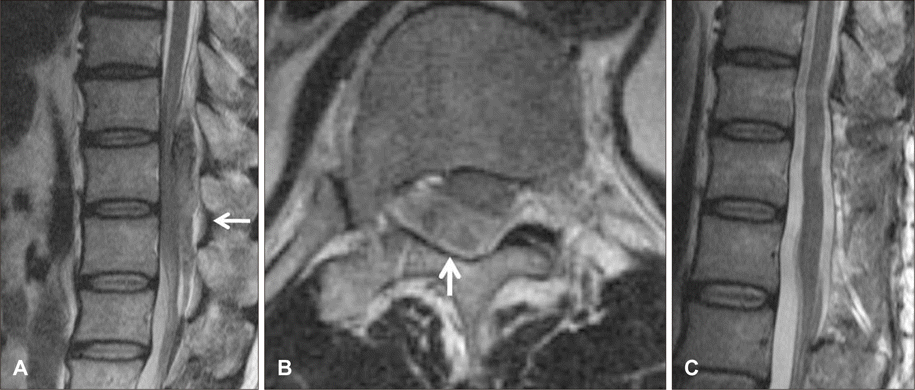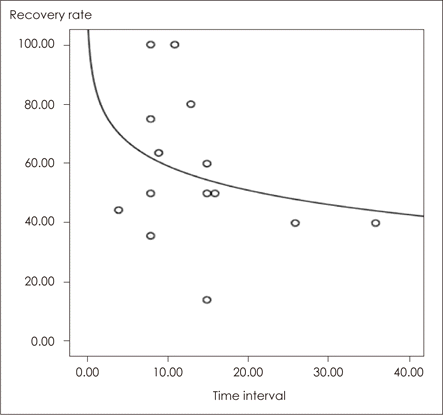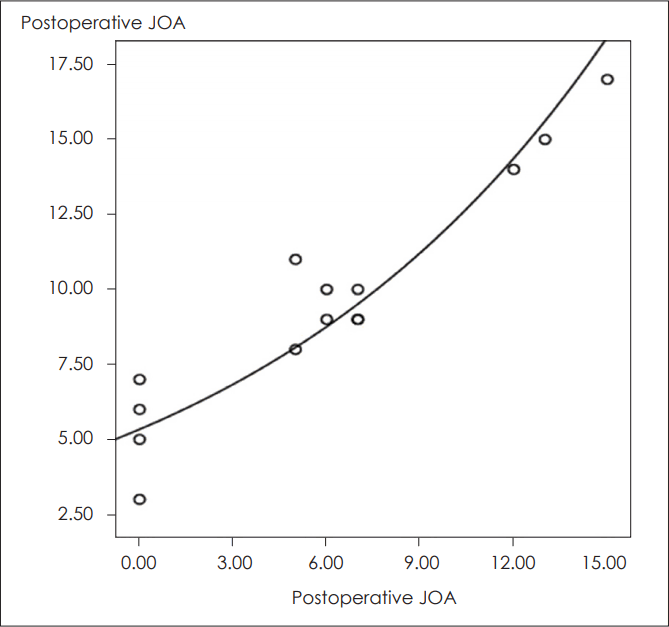1. Alexiadou-Rudolf C, Ernestus RI, Nanassis K, Lanfermann H, Klug N. Acute nontraumatic spinal epidural hematomas An important differential diagnosis in spinal emergencies. Spine (Phila Pa 1976). 1998; 23:1810–1813.
2. Hsieh CT, Chang CF, Lin EY, Tsai TH, Chiang YH, Ju DT. Spontaneous spinal epidural hematomas of cervical spine:report of 4 cases and literature review. Am J Emerg Med. 2006; 24:736–740.
3. Connolly ES Jr, Winfree CJ, McCormick PC. Management of spinal epidural hematoma after tissue plasminogen activator. A case report. Spine (Phila Pa 1976). 1996; 21:1694–1698.
4. Cooper DW. Spontaneous spinal epidural hematoma. Case report. J Neurosurg. 1967; 26:343–345.
5. Foo D, Rossier AB. Preoperative neurological status in predicting surgical outcome of spinal epidural hematomas. Surg Neurol. 1981; 15:389–401.

6. Fukui MB, Swarnkar AS, Williams RL. Acute spontaneous spinal epidural hematomas. AJNR Am J Neuroradiol. 1999; 20:1365–1372.
7. Groen RJ, van Alphen HA. Operative treatment of spontaneous spinal epidural hematomas: a study of the factors determining postoperative outcome. Neurosurgery. 1996; 39:494–508. discussion 508-509.

8. Gundry CR, Heithoff KB. Epidural hematoma of the lumbar spine: 18 surgically confirmed cases. Radiology. 1993; 187:427–431.

9. Jackson R. Case of spinal apoplexy. Lancet. 1869; 94:5–6.

10. Jonas AF. Spinal fractures. Opinion based on observations of sixteen operations. JAMA. 1911; 57:859–865.

11. Lawton MT, Porter RW, Heiserman JE, Jacobowitz R, Sonntag VK, Dickman CA. Surgical management of surgical epidural hematoma: relationship between surgical timing and neurological outcome. J Neurosurg. 1995; 83:1–7.
12. Leach M, Makris M, Hampton KK, Preston FE. Spinal epidural haematoma in haemophilia A with inhibitors--efficacy of recombinant factor VIIa concentrate. Haemophilia. 1999; 5:209–212.
13. Liao CC, Lee ST, Hsu WC, Chen LR, Lui TN, Lee SC. Experience in the surgical management of spontaneous spinal epidural hematoma. J Neurosurg. 2004; 100:38–45.

14. Lonjon MM, Paquis P, Chanalet S, Grellier P. Nontraumatic spinal epidural hematoma: report of four cases and review of the literature. Neurosurgery. 1997; 41:483–486. discussion 486-487.

15. Markham JW, Lynge HN, Stahlman GE. The syndrome of spontaneous spinal epidural hematoma. Report of three cases. J Neurosurg. 1967; 26:334–342.
16. McQuarrie IG. Recovery from paraplegia caused by spontaneous spinal epidural hematoma. Neurology. 1978; 28:224–228.

17. Miyagi Y, Miyazono M, Kamikaseda K. Spinal epidural vascular malformation presenting in association with a spontaneously resolved acute epidural hematoma. Case report. J Neurosurg. 1998; 88:909–911.
18. Miyakoshi N, Shimada Y, Suzuki T, Hongo M, Kasukawa Y, Okada K, et al. Factors related to long-term outcome after decompressive surgery for ossification of the ligamentum flavum of the thoracic spine. J Neurosurg. 2003; 99:251–256.

19. Tsai FY, Poop AJ, Waldman J. Spontaneous spinal epidural hematoma. Neuroradiology. 1975; 10:15–30.

20. Van Schaeybroeck P, Van Calenbergh F, Van De Werf F, Demaerel P, Goffin J, Plets C. Spontaneous spinal epidural hematoma associated with thrombolysis and anticoagulation therapy: report of three cases. Clin Neurol Neurosurg. 1998; 100:283–287.

21. Vayá A, Resureccin M, Ricart JM, Ortuño C, Ripoll F, Mira Y, et al. Spontaneous cervical epidural hematoma associated with oral anticoagulant therapy. Clin Appl Thromb Hemost. 2001; 7:166–168.

22. Penar PL, Fischer DK, Goodrich I, Bloomgarden GM, Robinson F. Spontaneous spinal epidural hematoma. Int Surg. 1987; 72:218–221.
23. Zuccarello M, Scanarini M, D\'Avella D, Andrioli GC, Gerosa M. Spontaneous spinal extradural hematoma during anticoagulant therapy. Surg Neurol. 1980; 14:411–413.





 PDF
PDF ePub
ePub Citation
Citation Print
Print




 XML Download
XML Download